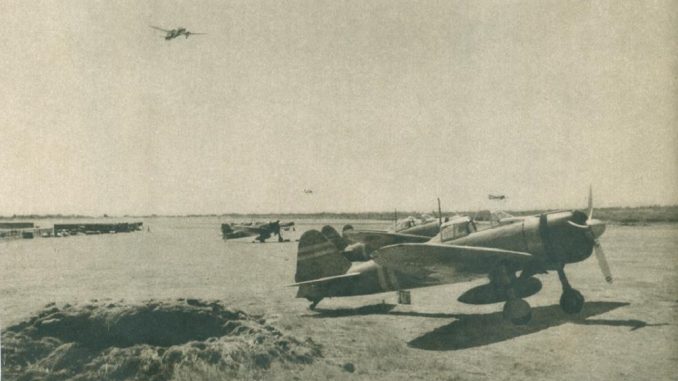
By the beginning of February 1942 the position of Java, the most important island in the Netherlands East Indies, was looking extremely precarious. Borneo and Celebes were already in Japanese hands, and Singapore and Sumatra were on the verge of falling to their advancing forces. A multi-pronged offensive aimed at Java was clearly on the cards. What was worse, the Allied contingents that made up the ABDA forces facing this threat were in some disarray. The Dutch ML-KNIL which was primarily responsible for the defence of Java was mainly equipped with outdated aircraft like the Brewster Buffalo and the Martin 139WH (an export version of the B-10). A handful of RAF aircraft would soon arrive in Java having fled Sumatra, but the main reinforcement effort was expected to come from the US Army Air Force.
Many American fighter pilots from the 24th Pursuit Group had been evacuated from the Philippines. These men regrouped in eastern Australia, where they were joined by green pilots and aircraft from convoys that had been diverted to Brisbane following the outbreak of war. Integrating these veterans into new ‘provisional’ fighter squadrons with the new arrivals would prove to be a time-consuming process, made more difficult by a lack of trained ground crews who could service the newly arrived P-40s. Even as these provisional squadrons completed their abbreviated training program and began to move toward the combat zone, the enormity of their task became evident. The route to Java was long and difficult, and plagued by bad weather. Many aircraft were lost to mechanical problems caused by a combination of inadequate maintenance and limited facilities on the intermediate airfields. Still more were lost when inexperienced pilots made mistakes, and yet more were lost to Japanese attacks on the supply route – Koepang on Timor was under attack by Japanese planes, and the major port of Darwin was bombed on the 19th of February.
The Americans were also trying to ship bomber aircraft to Java. The remnants of the 19th Bomb Group, decimated during the fight for the Philippines, had redeployed to Java and would carry out a series of bombing raids in defence of the island. The 27th Bomb Group with Douglas A-24 bombers were also trying to prepare their aircraft for a move to Java. The 27th had begun a move to Philippines before the war, but without aircraft – these were loaded on the ships of the Pensacola convoy that diverted to Brisbane after the attack on Pearl Harbor. The ground crews of the 27th were hampered due to missing parts for the crated A-24s, but gradually aircraft were being made fit for the journey to Java.
At the start of the battle for Java the core of the ABDA air force was the ML-KNIL, which fielded 65 fighters – Brewster Buffalos and Curtiss-Wright Hawk 75s and CW-21s – and around 45 Martin 139WH bombers (export B-10s). The MLD still had available several detachments of Do 24 and PBY flying boats, and the US Navy’s Patrol Wing 10 had several of their own PBYs still in service.
The Attack Opens
The Japanese opened their attack on Java with a fighter sweep conducted by Zeros of the Tainan Kokutai. Amongst the aircraft lost was a B-18 Bolo, carrying the commander of the 7th Bomb Group, Maj. Austin A. Straubel. This aircraft was shot down, and Straubel received serious burns in the ensuing crash. He died the following day.
On the following day there came the opening bombing raid of the assault on Java. A wide range of targets were attacked to pave the way for the impending invasion, with particular attention paid to the naval base at Surabaya and nearby airfields. Warned of the approaching bombers, seven Dutch Hawks and a dozen CW-21s took off to intercept. The Hawks soon encountered G3Ms from the Takao Ku who had failed to join up with their assigned escorts, and went into the attack. Several of the bombers were damaged and one claimed destroyed, but the A6Ms of the 3rd Ku arrived on the scene and began to maul the Dutch – five Hawks were shot down or forced to crash land. The 3rd also came across the CW-21s of 2-VLG-IV with much the same effect – four were shot down, and most of the survivors were damaged or their pilots were wounded.
With the skies clear of Allied fighters, the Japanese could concentrate on their targets. Several seaplanes and flying boats at Surabaya were strafed on the water or shot down nearby by the 3rd Ku, including several Do 24s of the MLD. Meanwhile, the Tainan Ku caught several 7th Bomb Group B-17s on the ground at Malang, destroying several of the big Flying Fortresses. The only bright spot in an otherwise miserable day for the Allies was the interception of a formation of G3Ms by P-40s of the 17th Pursuit Squadron, which resulted in one of the bombers being shot down. The 17th also claimed a Tainan A6M shortly afterwards.
On their way back to the bases at Kendari and Balikpapan, the Japanese bombers flew over an ABDA surface force consisting of the American cruisers Houston and Marblehead and the Dutch cruiser De Ruyter, plus several destroyers. Consequently the next day a strong force from the 23rd Air Flotilla set out to attack the ships by high-level bombing – no torpedoes had yet been delivered to the newly captured airfields. The first wave scored only near misses on the American ships, in return losing a single G4M to the guns of the Houston. A second wave had better aim, scoring two hits and a near miss on the Marblehead that threatened to sink her. Another bomb penetrated the Houston’s after turret, killing 50 men and wounding another 48. Both cruisers were able to limp back to Java, with the Marblehead being sent back to the US for repairs. The Houston would remain in Java.
Attention returned to Java itself on the 5th, with another large attack as the Japanese again attempted to break the defenders. The Tainan Ku lead the attack, heading for Surabaya. There they met the Dutch fighters that had survived the previous raid, and give them a thorough mauling – the last remaining Hawk 75s were shot down, and the handful of CW-21s were forced to run for their lives. P-40s of the 20th Pursuit Squadron were flying in from Australia and encountered Japanese fighters which attacked with similar results – six of the Curtiss fighters were shot down are badly damaged, gutting the squadron before it had even arrived in Java. Following these encounters, the Japanese again subjected Surabaya to a thorough strafing, with yet more flying boats destroyed on the water at the seaplane base. Some of the survivors set out to bomb Japanese shipping operating off southern Borneo on the 6th, but reprisals were swift and Surabaya’s seaplane base was subject to its third attack in a week, and 3 Do 24s were destroyed.
The Difficult Supply Line
Allied reinforcements continued to trickle in from Australia. On the 9th an LB-30 acted as a navigational guide for eight P-40s from the 3rd Pursuit Squadron and the first batch of the 27th Bomb Group’s A-24s. The planes became separated in bad weather, and only the A-24s managed to reach the refuelling stop at Timor. The P-40s, after various adventures, all failed to find the airfield at Timor and were forced to crash land on beaches and fields nearby. Their colleagues in the 17th Pursuit had better luck, when they were vectored to intercept a formation of G3Ms heading for Surabaya. One of the bombers was badly hit, and later seen to crash into the sea. This brief success was overshadowed by the fact that on the same day Western Java suffered its first raid, as the 22nd Air Flotilla attacked Batavia from its bases on the Malayan Peninsula. Four Dutch Buffaloes of 3-VLG-IV attempted to intercept but three of them were shot down or badly damaged. Two 139WHs and a few other aircraft were also destroyed during the attack.
Thereafter the beleaguered defenders of Java received a few days of respite, as the weather closed in and curtailed most flight operations. A few more P-40s managed to fly in, bringing the number of available American fighters to around 30. In the west, a consignment of RAF Hurricanes had been delivered to Batavia and ground crews hurriedly assembled them; they would soon be joined by the remnants of the RAF’s force on Sumatra, which would be forced to flee before the Japanese invasion of that island and the fall of Singapore.

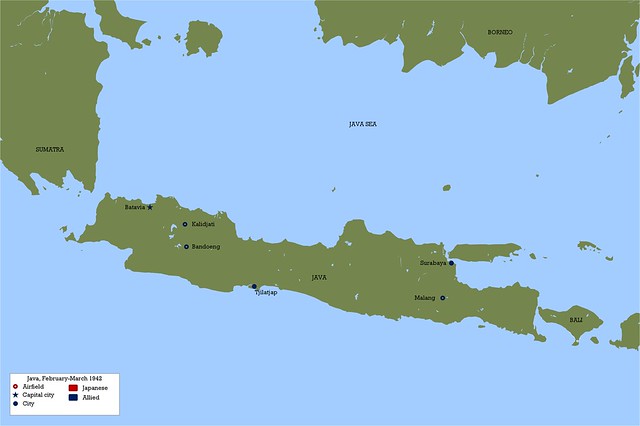

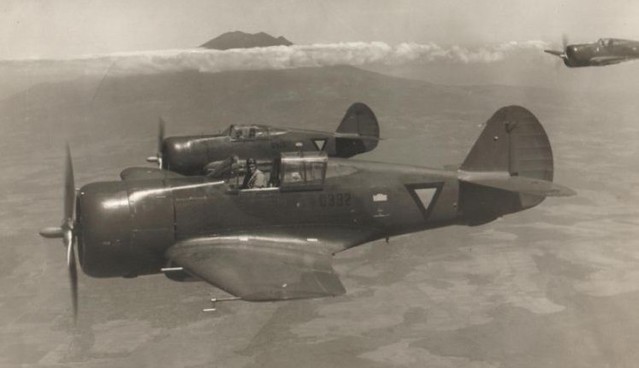
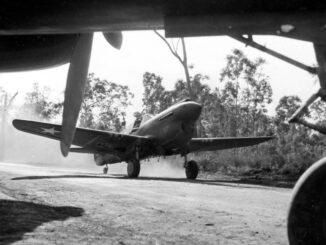
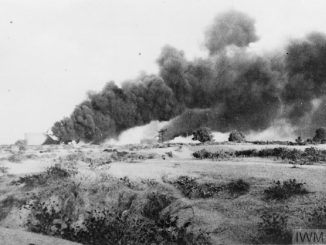
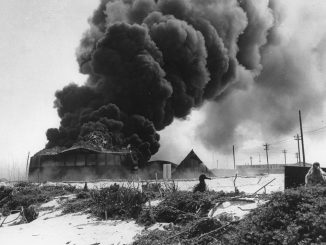
Leave a Reply